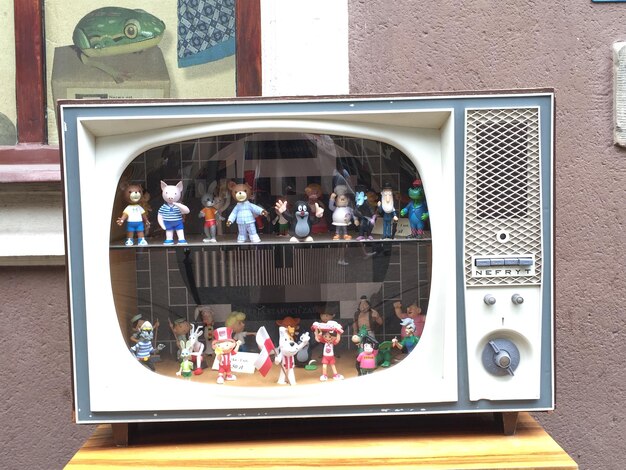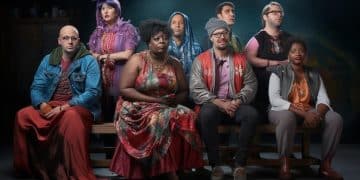The Power of Nostalgia: Revisiting Classic Series and Their Enduring Appeal

The enduring allure of classic series lies in their unique ability to evoke powerful feelings of nostalgia, transforming simple rewatching into a resonant journey back to cherished memories and simpler times, thereby solidifying their lasting cultural impact and appeal across generations.
There is a profound connection between our past and the media we consume, and nowhere is this more evident than in The Power of Nostalgia: Revisiting Classic Series and Their Enduring Appeal. Dive into why old shows continue to captivate audiences and what makes their charm so resilient.
The enduring allure of classic television series
The landscape of entertainment evolves constantly, yet certain classic television series consistently draw viewers back. This magnetic pull isn’t merely about escapism; it’s deeply rooted in our psychological makeup, tapping into a powerful emotional reservoir.
The concept of revisiting these shows transcends simple rewatching. It becomes an active engagement with our personal histories, a comforting embrace of what once was. This phenomenon is often attributed to nostalgia, a bittersweet longing for the past that provides comfort and a sense of continuity in a rapidly changing world.
The psychology behind nostalgic consumption
Nostalgia, particularly for television, acts as a psychological balm. When we re-engage with series from our childhood or youth, our brains release dopamine, creating a sense of joy and well-being. It’s akin to a mental safe haven, offering respite from present-day complexities.
- 📺 **Comfort and familiarity:** Classic series offer predictable narratives and beloved characters that provide a sense of security.
- 🧠 **Cognitive ease:** Our brains process familiar content more easily, making viewing less demanding and more enjoyable.
- 🛡️ **Stress reduction:** The act of recalling simpler times can significantly lower stress and anxiety levels.
Moreover, these shows often represent a time when personal responsibilities were fewer, and the world seemed less complicated. The act of watching them allows for a temporary return to that state, fostering a sense of relaxation and inner peace.
Generational bridges and shared experiences
Classic series also serve as crucial cultural touchstones, linking generations. Parents introduce their children to the shows they grew up with, creating new shared experiences and fostering intergenerational connections. This transfer of cultural capital ensures the longevity of these series.
Additionally, the communal aspect of discussing classic shows, whether online or offline, reinforces their appeal. Forums, social media groups, and fan conventions dedicated to these series demonstrate a vibrant, active community that keeps the flame of nostalgia burning brightly.
Defining “classic”: more than just age
What truly elevates a television series to “classic” status goes far beyond its age. While time is a factor, it is the profound impact a show has on culture, its ability to resonate across generations, and its lasting relevance that truly define its classic standing. A series becomes classic when it achieves a timeless quality, offering more than fleeting entertainment.
Classics often challenge societal norms, introduce groundbreaking narrative techniques, or create iconic characters that become part of the collective consciousness. They are shows that not only entertain but also provoke thought, spark conversations, and perhaps even inspire societal change.

Cultural impact and lasting influence
Many classic series have left an indelible mark on popular culture, influencing subsequent generations of creators and artists. Their dialogue, character archetypes, and plot devices are often referenced, parodied, or paid homage to in newer works, cementing their place in the cultural lexicon.
- 🌟 **Iconic characters:** Characters like Homer Simpson, Rachel Green, or Tony Soprano are instantly recognizable and have transcended their original shows.
- 🗣️ **Memorable lines:** Phrases such as “No soup for you!” or “Did I do that?” have become part of everyday language.
- 🎨 **Artistic innovation:** Shows like “The Twilight Zone” pushed boundaries in storytelling, influencing genres for decades.
The cultural influence extends beyond mere recognition; it shapes how future stories are told and how audiences perceive television as an art form. These series become reference points, benchmarks against which new productions are often measured.
Themes that transcend time
A true classic explores universal themes that remain relevant regardless of the era. Topics such as family dynamics, friendship, love, loss, good versus evil, and the human condition are perennial, ensuring that stories remain engaging for new audiences decades later. This timelessness allows these series to connect with viewers across different social and historical contexts.
For instance, “M*A*S*H” explored the absurdities and tragedies of war, themes that resonate beyond its specific historical setting. Similarly, “The Cosby Show” (despite later controversies surrounding its star) depicted family life in a way that resonated with millions, focusing on universal challenges and triumphs within domestic settings.
The syndication and streaming cycles: keeping classics alive
The advent of syndication in the mid-20th century, followed by home video, and now the pervasive nature of streaming platforms, has played a pivotal role in maintaining the visibility and popularity of classic series. These cycles ensure that shows produced decades ago remain accessible, allowing them to continually find new audiences and reinforce their existing fan bases. Without these mechanisms, many beloved series might fade into obscurity.
Syndication, once the primary method for rerunning shows, allowed series to reach broader audiences long after their initial network run. This business model fundamentally changed how television content was consumed and perpetuated the lifespan of successful programs. Streaming, however, has taken accessibility to an unprecedented level.
How streaming platforms revitalize old content
Streaming services like Netflix, Hulu, HBO Max, and Disney+ have become a digital haven for classic television. By making entire series available on-demand, they remove the barriers of scheduled broadcasts and physical media, transforming how viewers interact with content. This ease of access has sparked a resurgence in popularity for many older shows.
- 🌍 **Global reach:** Streaming platforms enable classic series to find audiences in countries where they were never originally broadcast.
- 🕒 **On-demand viewing:** Viewers can watch entire seasons at their leisure, facilitating binging and deeper immersion.
- 📊 **Data-driven curation:** Platforms use algorithms to recommend classic shows to new viewers based on their watch history.
Furthermore, the competitive nature of the streaming market encourages platforms to license extensive libraries of classic content, understanding its appeal to subscribers. This ensures a constant influx of previously inaccessible or hard-to-find series into the mainstream viewing pipeline.
The economics of nostalgia in entertainment
The enduring appeal of classic series is also a significant economic driver. Studios and networks benefit immensely from licensing their old content to streaming services. These deals provide a steady revenue stream, often with minimal additional production costs, making classic series incredibly valuable assets in the media economy.
Beyond licensing, merchandise, fan conventions, and even reboot discussions contribute to the economic ecosystem surrounding classic shows. The nostalgia economy isn’t just about rewatching; it’s about monetizing the affection and loyalty fans feel for these timeless productions. This continuous flow of revenue reinforces the incentive to keep these series alive and accessible.
Fan communities and their role in preservation
The vibrant and dedicated fan communities surrounding classic series are not mere passive consumers; they are active architects of preservation. Through forums, social media, fan fiction, conventions, and countless unofficial archives, these communities play a critical role in keeping the shows relevant and accessible. Their collective passion ensures that the legacy of beloved series continues to thrive, often bridging gaps left by official distributors.
These communities serve as living libraries, preserving obscure facts, producing elaborate theories, and digitizing rare content. They create a dynamic environment where new fans can be introduced to older shows and seasoned enthusiasts can deepen their appreciation and connection.
Digital archives and online discussions
The internet has revolutionized how fans interact with classic series. Dedicated websites, Reddit communities, Facebook groups, and YouTube channels are brimming with discussions, analyses, and fan-created content. This digital ecosystem ensures that even decades-old shows remain part of active online conversations.
- 📚 **Knowledge repositories:** Wikis and fan sites meticulously document every detail, character, and plot point.
- 💬 **Active forums:** Online communities provide a space for deep dives, theories, and shared experiences.
- 📹 **Fan-made content:** YouTube hosts countless video essays, compilations, and retrospectives that celebrate classic shows.
These digital spaces often become the primary source for discovering hidden gems or revisiting forgotten aspects of a series. They facilitate a constant re-evaluation and re-contextualization of content, keeping it fresh for new generations.
Conventions and fan gatherings
Beyond the digital realm, physical gatherings like fan conventions offer an immersive experience for enthusiasts. These events provide opportunities for fans to meet actors, writers, and fellow devotees, fostering a sense of belonging and camaraderie. From cosplay to panel discussions, conventions celebrate the communal love for classic series.
The ability to connect with others who share a similar passion for these shows reinforces the emotional bonds viewers have with them. These interactions create lasting memories and further solidify the classic series’ place within individual and collective consciousness. They are vital spaces for celebrating and perpetuating the fandom.
The cultural significance beyond entertainment
Classic series often transcend their original purpose as mere entertainment, evolving into significant cultural artifacts. They reflect and sometimes even shape the social, political, and technological landscapes of their time. By revisiting these shows, we gain insights not just into storytelling evolution, but also into historical shifts and societal values. They become living documents, offering a unique lens through which to examine past eras and understand our present.
The power of these series lies in their ability to act as time capsules, encapsulating the zeitgeist of their production periods while paradoxically retaining their relevance. They are more than just stories; they are cultural commentaries.

Reflecting societal norms and values
Many classic series inadvertently (or intentionally) serve as barometers of societal norms from their respective eras. From gender roles to racial dynamics, economic anxieties to technological aspirations, these shows often mirror the prevailing attitudes, prejudices, and aspirations of the society that produced them. Viewing them now offers a stark contrast or surprising similarity to contemporary perspectives.
For example, sitcoms from the 1950s often depicted highly traditional family structures, while those from the 1970s started to challenge those norms. Examining these narrative shifts provides a compelling timeline of social evolution, highlighting both progress and persistent issues.
Influence on language and popular culture
Classic series have a remarkable capacity to coin phrases, popularize slang, and even influence fashion and music. They become integral components of popular culture, with their impact extending far beyond the television screen. Catchphrases often enter the general lexicon, sometimes without new generations even realizing their origins.
- 👚 **Fashion trends:** Characters’ clothing choices often inspired trends that diffused into everyday wear.
- 🎶 **Soundtracks:** Iconic theme songs or featured music tracks gained massive popularity outside the show.
- 💡 **Technological adoption:** Shows occasionally introduced or normalized new technologies for audiences.
This enduring influence ensures that their cultural footprint remains visible, subtly shaping various aspects of our daily lives and expressions. It highlights how deeply embedded these narratives become within the fabric of society.
The future of classics: reboots, revivals, and new audiences
The continued appeal of classic series is not merely about looking back; it’s also about looking forward. The entertainment industry actively capitalizes on this enduring popularity through reboots, revivals, and spin-offs, aiming to capture new audiences while satisfying the nostalgic desires of existing fans. This constant reinvention ensures that the narratives and characters of classic shows remain part of the contemporary cultural conversation, adapting to modern sensibilities and technological advancements.
This trend underscores a fundamental truth about storytelling: compelling narratives and well-developed characters have timeless appeal, always finding a way to resonate, regardless of their original context.
Navigating reboots and revivals
The decision to reboot or revive a beloved classic is often met with a mix of excitement and trepidation. Fans hope for a faithful continuation or a fresh perspective that respects the original, while studios aim to leverage established intellectual property for new revenue streams. Successful reboots manage to strike a delicate balance, honoring the past while embracing the present.
Some reboots focus on continuation with original cast members, providing a sense of comfort and familiarity. Others opt for a complete reimagining, introducing new actors and storylines, which can sometimes alienate long-time fans but attract younger viewers. The quality and reception of these projects vary widely, highlighting the challenge of recapturing past magic.
Examples abound, from the mixed reception of certain sitcom reboots to the critical acclaim for more thoughtful revivals of dramatic series. The common thread is the power of the original narrative and characters to draw curiosity and engagement, regardless of the outcome.
Introducing classics to future generations
Beyond reboots, the inherent quality of many classic series means they naturally find new audiences. Children are introduced to the cartoons or family sitcoms their parents watched, initiating a new cycle of appreciation. This organic transmission of cultural content is crucial for the long-term survival of a series’ “classic” status.
- 👨👩👧👦 **Family viewing:** Parents sharing their favorite childhood shows with their kids.
- 🏫 **Academic study:** Classic series are increasingly part of media studies curricula.
- 🌐 **Social media discovery:** Viral clips or discussions introduce old shows to young, digital-native audiences.
The accessibility provided by streaming services also facilitates this generational handover, making it easier than ever for new viewers to discover and fall in love with shows that premiered long before they were born. This continuous onboarding of new fans ensures that the power of nostalgia remains a potent force in entertainment and beyond.
| Key Point | Brief Description |
|---|---|
| 💖 Nostalgia’s Role | Classic series evoke comfort, familiarity, and stress reduction through fond memories. |
| 🌟 Defining “Classic” | More than age; it’s about cultural impact, timeless themes, and lasting relevance. |
| 🔄 Streaming & Syndication | Key channels ensuring accessibility and revitalizing old content for new audiences. |
| 🚀 Future & Reboots | Continuing relevance fueled by reboots, revivals, and new generations discovering old favorites. |
Frequently asked questions about classic series
▼
Old TV shows often take us back to simpler times in our lives, connecting us with early memories, childhood, or specific periods of personal growth. This emotional connection provides comfort and a sense of continuity, contrasting with the complexities of modern life. The predictability of familiar narratives and characters also contributes to a feeling of safety and well-being, reinforcing their positive emotional impact.
▼
A TV series attains “classic” status through its lasting cultural impact, ability to resonate across generations, and exploration of universal themes. It often introduces iconic characters, memorable dialogue, and groundbreaking storytelling that influences subsequent media, embedding itself deeply into popular culture. Classics transcend their original broadcast era, remaining relevant and enjoyable for new audiences decades later due to their timeless appeal.
▼
Streaming platforms have revolutionized classic series accessibility by offering entire libraries on-demand, removing limitations of broadcast schedules. This global reach and ease of access allow older shows to find new viewers in diverse regions and facilitate binge-watching, deepening engagement. Streaming services also strategically license classic content, recognizing its value in attracting and retaining subscribers, thereby ensuring their continued visibility and economic viability.
▼
Absolutely. Fan communities are vital in preserving and promoting classic series. Through online forums, social media groups, fan fiction, and conventions, they maintain active discussions, create digital archives of information, and produce new content that celebrates their beloved shows. This collective passion keeps the series relevant and introduces them to new generations, ensuring their legacy endures far beyond official distribution efforts by fostering a dynamic and engaged fan base.
▼
The future of reboots and revivals is mixed but generally positive, given the strong nostalgic demand and economic incentives. While some reboots struggle to capture the original magic, successful ones manage to balance honoring the source material with fresh, contemporary storytelling. The continuous access provided by streaming platforms and the desire for familiar content suggest that studios will continue to explore these avenues, ensuring that classic narratives find new life and resonate with modern audiences.
Conclusion
The enduring appeal of classic series is a multifaceted phenomenon, deeply rooted in the human desire for comfort, familiarity, and a connection to the past. These shows transcend mere entertainment, becoming cultural touchstones that reflect societal shifts, foster intergenerational connections, and provide a much-needed sense of continuity in an ever-changing world. Powered by nostalgia, sustained by fan communities, and made accessible by modern technology, classic series will undoubtedly continue to captivate audiences for generations to come, proving that truly great stories, like cherished memories, never fade.





